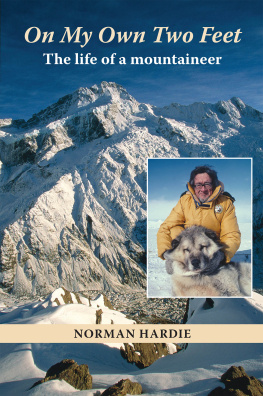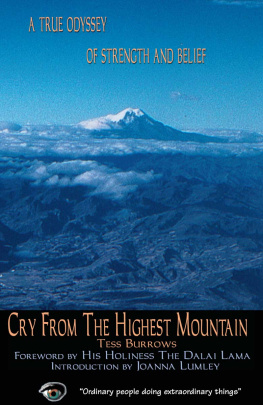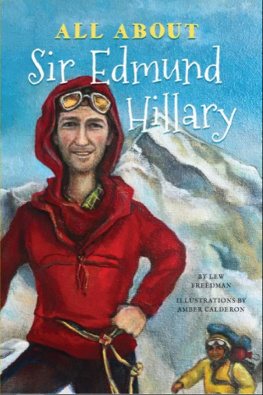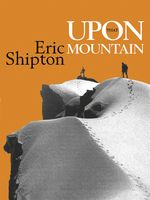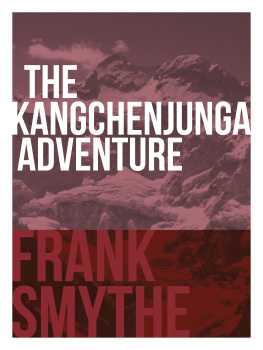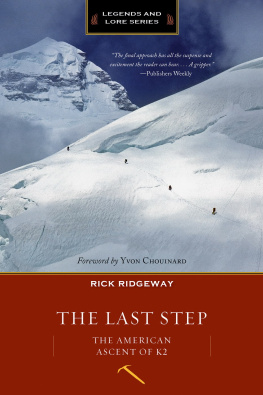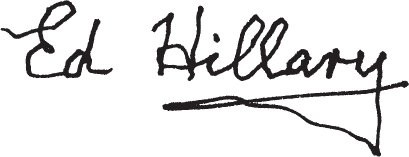This book arose initially from a desire to rectify omissions in the recording of some aspects of mountain exploration in the 1950s. With the encouragement of my family and my many mountaineering friends, it soon developed into an autobiography.
I give special thanks to my wife, Enid, who accompanied me on some journeys and made numerous constructive comments on the draft of my work. Colin Monteath was helpful in Antarctica, as well as in launching me back into the writing of a book after a 50-year gap. He, Jim Wilson and Ian Gardiner each checked a relevant chapter of the draft. Bill Beaven has been a regular companion in the mountains and in the business world. I discussed with him some of our earlier exploits before committing them to paper. I am grateful to Linda Harvey for some checking and much encouragement.
To Ian Gardiner again and to Peter Squires I owe 40-plus years of my life. They dragged me out unconscious from an avalanche during a tragic search operation.
Many friends have provided photographs, which are a vital part of the book. Photographs that do not carry credits are my own.
I acknowledge generous financial assistance towards publication from the New Zealand Alpine Club and the Federated Mountain Clubs of New Zealand Inc.
I am most grateful to Richard King and the staff of Canterbury University Press, to editor Rachel Scott and cartographer Tim Nolan for their professional input and support.
I t had not been my intention to write about my childhood in this account of where I have been in a long life. However, so many people have asked me, What made you get involved with big mountaineering? or Did your parents support the directions you took? Therefore I give this summary of my background, as I see it, after the passage of 60 and more years.
My parents had farmed a small property in Otago in the South Island of New Zealand during the early 1900s. Because of their earlier isolation neither had received any secondary education not unusual in those days. In rather depressed times they, with five small children, moved to Timaru, buying a four-acre property on the outskirts of that town. Usually my father just had part-time work, with a small income supplemented from his beehives and milk from cows on the mini-farm. Much of what we ate was grown on that land.
I was born in Timaru at the end of 1924. The complete family had five girls and three boys. Before the age of two I had double pneumonia and for some days, Ive been told, I drifted in and out of consciousness. Several times a day I had hot packs of antiphlogistene placed on my chest inside a tight wrapper. This is apparently a type of heat-retaining muck not now used. It was meant to be able to draw out congestion from the lungs. On one occasion, when the wrappings were removed, large areas of burnt skin also lifted. The resulting extensive scars are still with me, now partly hidden by a thin coating of hair, but in childhood they were a source of great embarrassment and stares from my peers. During my early years I hated taking off my shirt in sight of others.
When I was eight my brother Jim, aged 17, died of rheumatic fever, allegedly brought on by an earlier chilling at a badly organised scout camp. One of the results of the shock to the family was that I became the one to protect. If I coughed or wheezed I was kept away from school. At the beginning of high school my mother encouraged our doctor to certify that I was not strong enough to play rugby or cricket. For years I accepted that I must be a weakling. My older sisters took major parts in my upbringing , until two of them, in their late teens, left to undertake nursing training. I became very close to the three remaining sisters.
My parents were from strict Presbyterian stock, with my mother in particular believing in the literal truth of everything in the Bible. For us, Sunday attendance at church and Bible classes was compulsory and at various stages most of us sang in the church choir. Mother inflicted on us a weekly written biblical quiz, published in the Presbyterian magazine The Outlook. They were known as the OKPs the Outlook Knots and Puzzles. These were meant to instil an in-depth knowledge of the Bible, and to our mother they took priority over school homework. Liquor was banned from our house, and by the age of 12 most of us had signed The Pledge. I did have some sympathy for my mother. She had a hard struggle bringing up a large family during the Depression.
In spite of my weakness I was milking the cows and assisting my father with the bees by the age of 13. From these unpaid tasks I learned a lot, and I still have one beehive. My father and brother Jack were very good rifle shots and I was frequently away with them, shooting rabbits and sometimes wallabies. Our garage would often have scores of rabbit skins drying for the next skin sale. We saw much of the delightful South Canterbury foothills and I, too, soon became proficient with rifle and skinning knife. My father was also accomplished at fishing with a line and sinker. We spent hundreds of hours in various family combinations, on the furthest wharves and breakwaters of Timaru Harbour. Our efforts were usually highly successful. My fathers parents had come from a long line of seafarers in Scotland and he inherited an affinity for the large oceans. His ability to fix almost anything, with a limited range of tools, always amazed me. I tried hard to follow his example.
During my third year at Timaru Boys High School I grew several inches taller and found the internal motivation to do homework. I did manage to shake off the dreaded burden of OKPs, assisted by my close association with a neighbour, whose son was brilliant at all aspects of school life. This disappointed my mother, but gradually she accepted my wishes.
As I had been away from school sports for three years I was reluctant to join the established teams and their coaches. Instead I adopted isolated outdoor entertainment, particularly long-distance solo bicycle riding. At the end of my third school year I rode to Otekaieke, Moa Creek via Danseys Pass, near Alexandra, in Central Otago, next lap to Tuapeka, then Dunedin and home to Timaru, some 800 kilometres. The bike had no gears and the only bitumen road was the Dunedin main highway. There were many other big rides, one of the more significant being one to the Hermitage, Mt Cook, and a one-hour walk up one of the tracks. This made a great impression and I was determined to return.
I received a good grounding in classical music. My brother Jack and sister Gladys had singing lessons from a former operatic soprano, Mrs Tait. They sang by the piano in the room where I persevered with homework. From their practising I gained wonderful introductions to Handel oratorios, Schubert songs, Donizetti, Puccini and, most of all, Mozart. I can still quote more of the Bible from oratorios than I ever absorbed from the compulsory OKPs.

